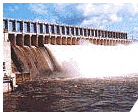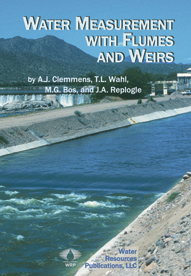

 |
 |
||||||
 |
Title: Water Measurement with Flumes and Weirs
|
DESCRIPTION
Due to popular demand, this current and viable publication was reprinted in hardcover in 2010. It integrates
the 1984 book Flow Measuring Flumes for Open-Channel Systems
and the 1993 book FLUME: Design and Calibration of Long-Throated Measuring
Flumes, which introduced the first interactive flume-design software. Chapter
8 contains the new Microsoft Windows version of FLUME, WinFlume. This computer
program will assist in developing the hydraulic design of long-throated flumes
and broad-crested weirs for user-specified channels, to satisfy user-specified
boundary conditions and design requirements. The program will also determine the
head versus the discharge calibration (the rating) of newly designed and existing
structures. WinFlume is an upgrade from the previous programs. WinFlume can be
downloaded from winflume/index.html.
It's most notable improvements are a better user interface for the Windows operating
systems, additional output options, and an improved design module.
Long-throated flumes and broad-crested weirs have evolved significantly in recent years, and several of them are now commercially available. Chapter 3 discusses new construction techniques and the structures that are on the market, and contains illustrations of many successful installations from around the world.
The range of applications of these flumes and weirs is unlimited. The authors hope that this book will contribute to the effective management of one of Earth’s most widely needed, intensively used, and extensively wasted natural resources: water.
The primary advantage of using flumes and weirs to measure water flow is the theoretical predictability of their hydraulic performance. The long-throated flumes and broad-crested weirs, especially, have several major advantages over all other known weirs and flumes (e.g. Parshall flumes, cutthroat flumes, H-flumes, sharp-crested weirs, and so on). These advantages are:->Provided that critical flow occurs in the throat, it is
possible to calculate a rating table with an error of less than 2% of the listed
discharge. The calculation can be made for any combination of prismatic throat
and arbitrarily shaped approach channel.
->The throat, perpendicular to the direction of flow, can be shaped in such
a way that the complete range of discharges can be measured accurately.
-> Minimal head loss over the weir or flume is required to ensure a unique
relationship between the upstream sill-referenced head, h1, and the discharge,
Q.
->This head-loss requirement can be estimated with sufficient accuracy for
any of these structures placed in an arbitrary channel.
-> Because of their gradual converging transition, these structures have
little problem with floating debris.
->Field observations and laboratory tests have shown that these structures
can be designed to pass sediment transported by open channels with sub-critical
flow.
-> Provided that the throat is horizontal in the direction of flow, it is
possible to compute a rating table with post-construction dimensions. Thus,
it is possible to produce an accurate rating table even if the flume is not
constructed to the design dimensions. It is also possible to reshape the throat
as needed, according to changing site conditions, and compute a new rating table
with the modified dimensions.
Under similar hydraulic and other boundary conditions, long-throated
flumes and broad-crested weirs are usually the most economical of all structures
for accurately measuring open-channel flows, provided that conditions are such
that a weir or flume is feasible.
Because of these advantages, long-throated flumes and broad-crested weirs are
useful for various flow-measurement applications, particularly when the structure
must have a minimal impact on existing flow conditions and water-surface elevations.
Improved management of our water resources is needed to ensure the equitable distribution of water among competing users. There are especially significant opportunities for conservation and more effective use of water by the world’s largest user, agriculture. To improve water management, the authors recommend including water-measuring capability in all new water projects and retrofitting existing water projects for water measurement as soon as possible.
For measuring flow in open channels, the authors recommend long-throated flumes. These belong to an extensive family of structures that includes broad-crested weirs with a streamlined flow contraction. Broad-crested weirs are particularly suitable for use in irrigation canals and long-throated flumes are well adapted for use in natural streams. The range of potential applications of both types of structures in various types of channels and ranges of flow rates is unlimited.